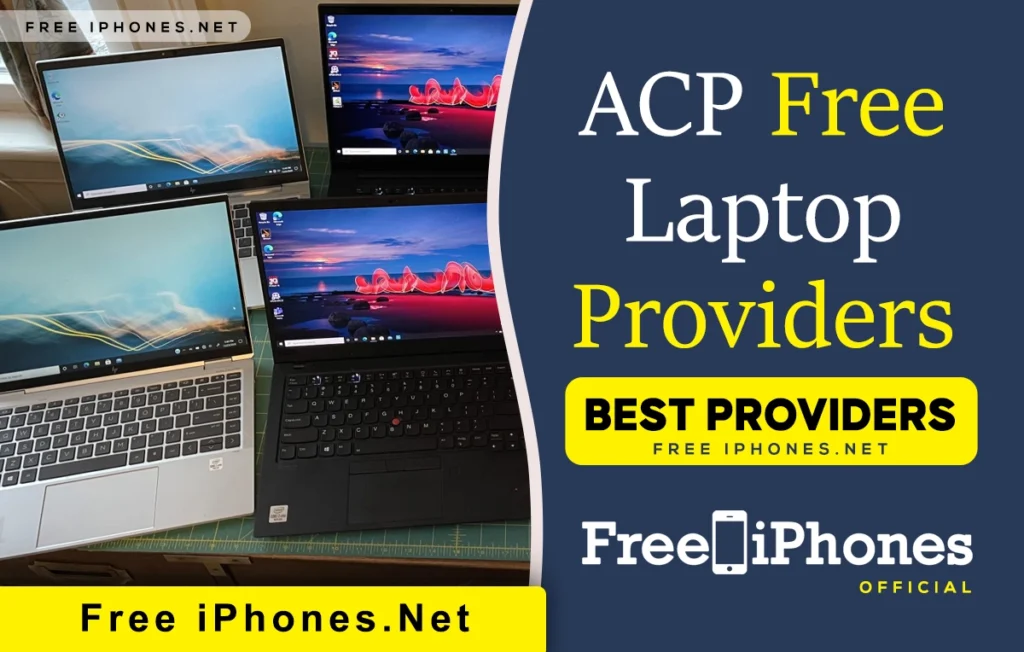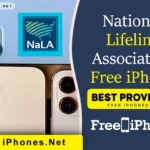Access to technology is a luxury in today’s fast-paced digital world and a necessary means of continuing education, pursuing professional possibilities, and maintaining global connections. Yet, obtaining these essential items may be a difficult task for people and households with little money.
The Affordable Connectivity Program (ACP) is a ray of light for struggling individuals. It provides free computers and other gadgets to those in need. Let’s explore at Free iPhone about ACP Laptop Providers in more detail, where technology meets the need, and the ACP helps the low income families by providing tools such as PC, Computers and laptops for growth and empowerment.
ACP Laptop Providers
By participating in the ACP, several ACP program laptop providers close the connection gap. Numerous companies, such as Assurance Wireless and Xcess Telecom, are dedicated to giving away ACP free laptops and other items. Every program has its special features and requirements for eligibility.

List of ACP Free Laptop Providers:
- Assurance Wireless
- Airtalk Wireless
- Boomerang Wireless
- QLink Wireless
- Cintex Wireless
- Century Link
- Frontier Wireless
- SafeLink Wireless
- Access Wireless
- American Assistance
- Blue Jay Wireless
- Feelsafe Wireless
- SafetyNet Wireless
- Standup Wireless
- Life Wireless
- Tag Mobile
- Tempo
- Terracom Wireless
- TruConnect
- Easy Wireless
- Choice Wireless
- Starry Internet
- Suddenlink
- Xfinity
- Xcess Telecom
Eligibility Criteria for ACP Free Laptop Providers
ACP eligibility requires the fulfillment of the following requirements:

Income Threshold:
The main need to be eligible for the ACP is income. If a household’s income is less than 200% of the Federal Poverty Guideline, they are deemed suitable. This threshold point guarantees that those with modest financial means, including families, can take advantage of the program’s services. You can also apply for Free 5G Government Phones through ACP and Lifeline Programs.
Lifeline Program Requirements:
ACP eligibility can be attained by participation in the Lifeline program. Benefits from ACP may be accessed through Lifeline, which offers monthly savings on phone, internet, and voice services to any eligible member of your home. With a $9 monthly discount (or $34 for tribal regions), Lifeline promotes increased accessibility to essential communication services.
Participation in Specific Federal Initiatives:
Qualifying households can become eligible for the ACP by taking part in various federal programs such as Medicaid, Supplemental Security Income (SSI), SNAP (Supplemental Nutrition Assistance Program), Federal Public Housing Assistance, and Special Supplemental Nutrition Program for Women, Infants, and Children (WIC). Participation in these programs, which serve various needs, is a sign of eligibility for ACP benefits.
Tribal-Specific Programs:
Households are also eligible for ACP benefits if they participate in tribally-specific programs, including food distribution programs on Indian reservations, the Bureau of Indian Affairs General Assistance, and Tribal Temporary Assistance for Needy Families (TANF). These initiatives provide fair access to connection resources in recognition of the particular difficulties that Native American communities experience.
Federal Pell Grant Recipients:
Benefits under the ACP are available to students who are Federal Pell Grant recipients for the current award year. The program’s support for educational endeavors is broadened by this addition, which acknowledges technology’s essential role in contemporary learning contexts.
Eligibility for Low-Income Internet Programs:
ACP benefits eligibility is further confirmed by meeting the requirements for participating ACP program laptop providers in the current low-income internet programs. This criteria ensures that it aligns with existing programs that promote digital inclusion for low-income households.
How to Apply for a Free Government Laptop
To guarantee that those in need may easily obtain this crucial resource, the Affordable Connectivity Program (ACP) application procedure is simple to use and accessible:
1. Check Eligibility:
Please confirm that you fulfill the program’s eligibility requirements before starting the application. This entails fulfilling certain Lifeline program requirements or ensuring your family income is less than 200% of the Federal Poverty Guidelines.
2. Select a Provider:
Review a long list of partnering providers and choose one that best suits your requirements and tastes. Consider elements like coverage, available device alternatives, and any extra services.
3. Application Submission:
After you have chosen the right provider, you can start the application process by visiting their website or contacting one of their designated support channels. The majority of suppliers provide easily navigable online application forms that are intended to gather the required data.
4. Compile the Required Documents:
Get the necessary paperwork ready to prove your eligibility. This might be evidence of income, enrollment in a particular government aid program, or other pertinent credentials.
5. Finish and Submit Application:
Fill out all sections of the application form and attach any required documents. Before submitting, carefully review the details provided to ensure correctness and completeness.
6. Verification Process:
After submitting your application, The provider will ensure you are eligible. This stage may entail asking for clarification or conducting further correspondence to verify the information supplied.
7. Await Approval:
The supplier will process your application when it has been successfully verified. The amount of applications and the processing times of the various ACP program laptop providers affect the approval deadlines.
ACP Free Laptop Providers: Delivery Timelines & Devices
Participants excitedly await the delivery of their equipment, which usually consists of laptops, tablets, or desktop computers, after being certified for the ACP. These are more than just devices; they are doors to higher learning, better job prospects, and increased connectedness. However, there are several reasons why different suppliers may have other delivery times:
- Demand and Availability: Delivery timeframes may be impacted by the popularity of the program and the available inventory of devices. Longer wait times might be caused by increased demand.
- Processing and Logistics: The logistical procedures for approving applications, acquiring hardware, and setting up shipments are crucial. Although providers work hard to speed up these processes, their complexity may affect delivery times.
- Geographical Location: Depending on where you reside, different delivery times may apply. Delivery can take longer in remote locations or where logistics are difficult.
The duration for receiving devices post-approval can vary, ranging from a few weeks to a few months. This timing difference does not reflect the program’s efficiency but is attributed to the high volume of responses and the providers’ dedicated efforts to fulfill requests promptly.
Denied ACP Laptop Application: What Are Your Options?
If you are rejected, don’t give up. After resolving the previous denial’s reasons, you can submit another application.
Understanding the Rejection Reasons:
First, go over the program’s letter or rejection notice very attentively. It is critical to comprehend the precise grounds for rejection. It might be anything from not satisfying specific qualifying requirements to needing more documents.
Addressing Documentation Issues:
If the paperwork was deemed insufficient or inaccurate, promptly address and resolve the issue. Ensure all essential paperwork is obtained, completed, and submitted on time. Verify again for any mistakes or missing details that might have contributed to the rejection.
Reassessing Eligibility Criteria:
Go over the qualifying requirements one more time. Rejection occasionally results from failing to satisfy certain requirements. Ensure any modifications to your situation that meet the requirements are properly noted and recorded in your reapplication.
Seek Clarification and Guidance:
Speak with the organization in charge of the applications or the program provider. Find out why you were rejected and whether you can access an appeals procedure. Knowing the reasons behind a denial can enable you to better prepare your case for a reapplication or appeal.
Precision in Reapplication:
Remember to pay close attention to every detail when reapplying. Give correct information and the required documentation. Highlight any modifications or extra requirements that now meet the qualifying conditions. If the first rejection resulted from a miscommunication or a documentation error, create a concise and understandable justification.
Persistence and Patience:
Continuity is essential. Remember that the denial may result from administrative or documentation errors rather than a reflection of your eligibility. Throughout the process, show that you are committed to adhering to the program’s criteria by being persistent and patient.
Finding Alternative Options:
If, despite efforts, approval remains elusive, explore alternative avenues for device acquisition. Seek more aid programs or community projects that offer comparable help. Furthermore, find out whether the program provides advice or connections to other services that could help.
How Long will the Affordable Connectivity Program Last?
While the ACP is a great tool, knowing how long it will last is important. According to the currently available information, the program is expected to help eligible people and households for a considerable time. Nonetheless, government initiatives are often reviewed and updated.
This program is overseen by the Federal Communications Commission (FCC), and while a specific end date has not been specified, ongoing evaluations guarantee its viability and efficacy. Suspension is dependent on government actions and the availability of financing. It’s best to remain informed about extensions or programming modifications using proper sources.
To promote long-term digital inclusion, the Affordable Connectivity Program was established. Thus, attempts are continuously made to increase its duration so that more people and families may take advantage of this program.
FAQs
Multiple Discounts in ACP Laptop Providers: Exploring Limits
A common question about the Affordable Connectivity Program (ACP) is whether households are eligible for more than one discount. The answer is no; the ACP only allows a family to get a single monthly internet subscription discount and a single device discount. This policy ensures the equitable distribution of opportunities and resources among qualifying households.
Understanding ACP Benefit Renewal
One often-asked question is if ACP benefits are automatically renewed annually. The answer is no. Yearly renewal of the ACP benefits is optional. You must re-enrol with your service provider each year to continue receiving program benefits. However, you will not have to reapply through the National Verifier if you have already applied and been accepted.
This procedure allows ACP program laptop providers to efficiently manage resource allocation while guaranteeing that program participants receive ongoing assistance. Therefore, even when the advantages are not automatically renewed, it is still simple to re-enroll and maintain access to crucial connection resources. You can also apply for Free Government Smartphones through different programs.
Eligibility of Legal Immigrants for the ACP Laptop Providers
Narrow concerns must be considered when navigating government aid program eligibility requirements, especially for legal immigrants. Regarding immigration eligibility, the Affordable Connectivity Program (ACP) adheres to particular regulations. Generally, candidates for government assistance programs must be lawful permanent residents (LPRs) and have been in their current state for at least five years—a requirement known as the “five-year bar.” Some exceptions avoid this five-year requirement for several categories, including refugees, asylum applicants, and immigrants from Haiti, Cuba, and Asia.
It’s crucial to understand that those on non-immigrant or temporary visas are frequently ineligible for government benefits like the ACP. Still, a critical provision remains: an individual may apply for the ACP even if they have not been a legal resident for five years and qualify for it owing to income constraints or involvement in a government assistance program. This clause recognizes the financial hardship and possible marginalization that recently arrived lawful immigrants may encounter.
Applying for ACP Free Laptop Without Existing Internet Service
It is possible to initiate the ACP procedure without an internet connection. Follow the steps below to begin:
- Contact an ISP: Set up an account with the Internet Service Provider to get a connection.
- National Verifier Application: Once you have internet connectivity, go to the National Verifier website and apply.
- ACP Benefit Application: After completing the National Verifier procedure, immediately apply for the Affordable Connectivity Program reward. This is normally done through the website of your selected provider or by following their application method. You can streamline your eligibility for the ACP and eventually profit from its programs by ensuring an internet connection and navigating the application steps quickly.
Dealing Rejections from National Verifiers
It’s not the end of the road if the National Verifier rejects your application. Rejection frequently indicates that more paperwork is required. It may occasionally be required to submit your papers again, up to three times, to gain approval.
Final Thoughts
The Affordable Connectivity Program is a doorway to empowerment and inclusiveness in the digital sphere, not just a means of dispensing gadgets. ACP is a change agent that creates an atmosphere where people of all economic means may prosper at a time when connectivity is often associated with opportunity. As we navigate a constantly developing world, the Affordable Connectivity Program serves as a beacon of hope. It symbolizes our common commitment to a more just society and emphasizes the critical significance of technology access as a fundamental right, not a privilege.










